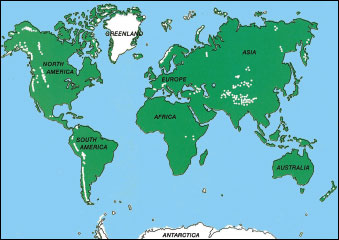My trip to Alaska got me thinking about snow, ice and glaciation. There were glaciers aplenty on the Kenai Peninsula but that’s not unexpected at sixty degrees north of the equator. Where, I wondered, was the southernmost glacier in the northern hemisphere?
It’s not the first time my mind has wandered in this basic direction. Several months ago it led me to search for the Southernmost Northern Permafrost. Permafrost is one thing. However, glaciation is an even more impressive phenomenon due to its imposing will and presence. Snow compressed into ice over decades or centuries sides crushingly downhill through the power of its immense weight, scouring and carving the landscape slowly as it descends.
I first considered that the southernmost glacier in the northern hemisphere would need to be fairly far north, maybe somewhere like Montana with its famous Glacier National Park. Latitude certainly plays a role in that but it’s not the only force at work here. I considered another factor that I knew would influence the answer: elevation. Fortunately I stumbled upon a publication from the U.S. Geological Survey the proved to be extremely valuable during my quest, the Satellite Image Atlas of Glaciers of the World.
Mexico?

Until I saw this map I thought the answer might bring me to Mexico. The USGS publication describes the situation rather succinctly:
“Glaciers in Mexico are restricted to its three highest mountains, all stratovolcanoes. Of the two that have been active in historic time, Volcán Pico de Orizaba (Volcán Citlaltépetl) has nine named glaciers, and Popocatépetl has three named glaciers. The one dormant stratovolcano, Iztaccíhuatl, has 12 named glaciers. The total area of the 24 glaciers is 11.44 square kilometers.”
No. South America!
The map, however, completely blew that theory out of the water. The answer isn’t North America. No, it’s South America. There isn’t much of South America that extends into the northern hemisphere so it’s not the most intuitive answer, but that’s where the map led me. It’s not the largest map and it doesn’t have the greatest level of detail so I eyeballed it and guessed that maybe I should focus on Colombia.
I turned to the Glaciers of Columbia pages. There are several to choose from and I quickly selected the southernmost location from the list.
Nevado del Huila

Nevado del Huila climbs 5,365 metres (17,602 ft) as part of the Cordillera Central, the Colombian Andes (map). It’s a volcano topped by a 13 square kilometre glacier, and it’s only 2.92° north of the equator. The volcano had been dormant for hundreds of years but came back to life recently including an event in 2008. It’s impressively close to the equator but unbelievably it doesn’t take the prize for the southernmost northern hemispheric glacier.
I squinted at the map further and wondered if maybe some of the white markings in Ecuador might spill to the northern side of the equator. I thumbed over to the Glaciers of Ecuador pages and found my answer. The publication notes that glaciers in Ecuador don’t spawn from huge icefields like those in the colder latitudes, rather they’re confined to ice caps on the highest of Andean mountains. Nonetheless they’re glaciers and they still count.
Cayambe

Two spurs of the Andes run through Ecuador near the equator, Cordillera Oriental (east) and Cordillera Occidental (west). Both of them have a single glaciated peak that happens to extend north of the line. At only 0.02° north latitude, the Cayambe Volcano of the Cordillera Oriental (map) just edges out the other contender, Cotacachi.
Cayambe climbs to 5,790 metres (18,996 feet) which demonstrates the immense elevation necessary to spawn 20 outlet glaciers from a 17.72 square kilometre ice cap sitting practically on the equator. That’s the surprising answer though. The southernmost northern hemispheric glacier is only about two kilometres north of the equator.
In the next installment I discuss the opposite situation, the Northernmost Southern Hemispheric Glacier

Leave a Reply